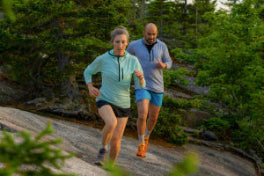10 Essential Things To Take Hiking
Wondering what to pack for a hike? Whether you're venturing into the backcountry or heading out on a local loop, these Ten Essentials are the foundation of a safe and successful hiking trip. From navigation tools to layering with Merino wool, this guide breaks down the gear you need to stay safe, comfortable, and prepared for the unexpected—no matter the trail or terrain.

1. Navigation
Every safe hike starts with a solid plan. Always carry a map, compass, or GPS device—ideally more than one method. Know your route ahead of time and make sure you’re confident using your tools before heading into the backcountry.
Pro Tip: Learn how to read a topographic map and use your compass before your trip. How to use a compass (American Hiking Society)

2. Insulation
Weather in the mountains and forests can shift fast. Stay ahead of it by layering with Merino wool base layers, which regulate temperature, wick moisture, and keep you warm—even when wet.
Why Merino wool? It’s naturally odor-resistant, breathable, and perfect for changing conditions. Shop Merino Wool Mid-Layers
Pro Tip: Always bring an extra warmth layer and a rain/wind shell.

3. Sun Protection
Even on cloudy days, UV rays can do damage. Wear sunscreen, UV-rated sunglasses, and a wide-brimmed hat. Choose lightweight, breathable clothing with built-in sun protection—especially for high-altitude or all-day treks.
Pro Tip: Sunglasses and sunscreen can be just as important in winter as in summer.

4. Illumination
It gets dark quickly in the woods, especially if your hike runs long. Pack a headlamp or flashlight with extra batteries. Look for a model that’s durable, waterproof, and has long battery life.
Pro Tip: Don’t rely on your smartphone for light.

5. First Aid Supplies
Scrapes, blisters, and more serious injuries can happen even on easy trails. Bring a first aid kit stocked with bandages, antiseptic wipes, gauze, tape, pain relievers, antihistamines, and any personal medications.
Pro Tip: A first aid kit can grow or shrink depending on the size of your adventure.

6. Fire
A fire can warm you up, cook your food, or act as a signal. Pack waterproof matches, a lighter, or a firestarter in a sealed container. Check local fire regulations before you go and always follow Leave No Trace principles.
Pro Tip: Even if you don’t plan to use it, fire-starting gear could save your life.

7. Repair Kit and Tools
If your gear breaks in the wild, a simple repair kit can save the day. Bring a multi-tool, knife, and duct tape to handle everything from ripped packs to busted boots. A small sewing kit or patch kit can also come in handy.
Pro Tip: A knife & duct tape go a long way.

8. Nutrition
Always bring more food than you think you’ll need—especially calorie-dense snacks like trail mix, energy bars, or jerky. Peanut butter & jelly sandwiches make a great calorie dense & easy to pack meal. Your body burns more fuel than usual on the trail, especially in cold weather or steep terrain.
Pro Tip: Pack an emergency backup snack in case you're delayed or stuck overnight.

9. Hydration
Dehydration can sneak up on you. Always bring more water than you need, and pack a lightweight filter or purification tablets if you're heading far from the trailhead.
Pro Tip: Drink before you're thirsty. Consider electrolyte supplements on long, hot hikes.

10. Emergency Shelter
Even if you’re not planning to camp, carry a compact emergency shelter like a bivy sack, space blanket, or tarp. It can protect you from wind, rain, or cold if you're injured or delayed.
Pro Tip: Shelter is one of the most overlooked essentials—don’t skip it.

11. Good Socks (Bonus) - Really Important
Bad socks can seriously ruin your day. Blisters, odor & rubbing are just a few of the problems caused by low-quality socks. If you're hitting the trail don't be caught wearing cotton or plastic socks.
Here are a few key factors that make a high-quality sock:
Fit - A good sock should feel snug when you put it on. That close fit prevents bunching, slipping, and rubbing - a major causes of blisters.
Materials - Merino Wool is the gold standard. It's naturally moisture-wicking, anti-odor, and thermoregulating to keep your feet comfortable in any condition. Not all Merino socks are created equal. Check the label... some brands skimp on the wool. At Minus33, most of our socks contain over 60% Merino for maximum performance.
Construction - Look for seamless toes, targeted cushioning, and reinforced heels. These design features add durability and comfort where it counts.
Pro Tip: Get Some Minus33 Merino Wool Socks - You Wont Regret It
Final Thoughts: Be Prepared, Not Scared
Packing the Ten Essentials ensures you’re ready for whatever the trail throws at you. Whether you're chasing a summit or strolling through your local forest, having the right gear—from Merino wool layers to a dependable light—can make all the difference.
Respect the wilderness, know your limits, and always follow Leave No Trace.
Hiking in New Hampshire offers some of the most stunning and challenging terrain in the Northeast, with its rugged mountains and scenic trails. Before hitting the trail, it’s essential to be prepared, and New Hampshire's HikeSafe program provides great resources for hikers. HikeSafe not only promotes safety and preparedness but also offers rescue insurance, covering the cost of search-and-rescue operations if you find yourself in an emergency. Many states have similar programs, so it’s worth checking if your local state offers a comparable program to ensure you're fully equipped for your adventure.
When packing for a hike, Merino wool should be at the top of your essentials list. As one of the best materials for hiking, Merino wool offers moisture-wicking, temperature regulation, and odor resistance-all critical when you're carrying a heavy load while hiking. Whether it’s a base layer, socks, or a lightweight hoodie, Merino wool keeps you comfortable through changing conditions. If you're making a list of the 10 things to bring hiking, don’t leave home without quality Merino gear-it’s built for the trail.






